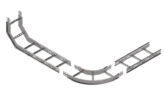
Does metallic cable tray/ladder require bonding? The experts at the ECA offer some easy identification tips.
Many contractors, engineers and consultants find this particular topic to be a little confusing, so this article is designed to give authoritative guidance on the subject. Put simply, the answer will depend on what the tray/ladder is used for. If:
a) The tray/ladder is an exposed-conductive-part it WILL require earthing;
b) The tray/ladder is an extraneous-conductive-part it WILL require bonding;
c) The tray/ladder is neither an exposed/ extraneous-conductive-part then it WON’T require earthing or bonding.
As can be seen, the relevance of earthing/bonding will depend on the nature of the tray/ladder. It’s worthwhile
here defining what an exposed or extraneous-conductive-part is:
Exposed-conductive-part
This is a conductive part of equipment which can be touched and isn’t normally live, though it may become live under fault conditions.
Conclusion
In order for the tray/ladder to be an exposed-conductive-part, and therefore require earthing, it must be used as a
protective conductor as per the requirements of BS 7671:2008 Regulation 543.2.1.
If the tray/ladder is carrying sheathed and/or armoured cables (which it most likely will be) then the nature of that type of cabling suggests that the tray/ladder won’t require earthing as the cable has adequate mechanical protection i.e. more than just basic insulation. This meets the requirement of Regulation 412.2.4.1 and therefore the tray/ladder doesn’t need earthing.
Note: the requirements are different for trunking and conduit, (both of which enclose the cables) where single insulated cables are likely to be installed.
If the tray/ladder is to be classed as an ‘extraneous-conductive-part’ then as well as clearly not being part of the electrical installation, it also needs to be proven that it’s not in fortuitous contact with Earth.
If these two conditions can be met, then there will be no need to provide equipotential bonding to it.
How to determine if it’s an extraneous-conductive-part
For this, a simple measurement is undertaken. This is done by testing the resistance between the suspected extraneous-conductive-part and the MET or the nearest known connection to Earth, such as the circuit protective conductor (CPC) of a local circuit (so long as its connection to Earth has been verified).
Published guidance by the IET suggests that if the ohmic value between the suspected extraneous part and Earth is greater than 22 kΩ, then the part in question is considered as unable to introduce a shock risk and, as such, won’t require bonding.
To measure this sort of reading will require the use of the insulation resistance testing range (MΩ) where 22 kΩ will usually be displayed as 0.02 MΩ.
If the test reading indicates anything greater than 0.03 MΩ, then it may be concluded that the item in question isn’t likely to introduce a dangerous potential and therefore wouldn’t require bonding.








